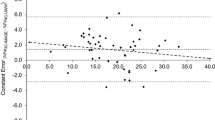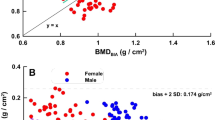Abstract
Background/objectives
Dual-energy x-ray absorptiometry (DXA) has been suggested as an alternative method for estimating body volume (BV), a component of the reference four-compartment body composition model. This study reports the development and validation of DXA-BVSilva, a novel DXA-derived BV equation. An additional aim was to develop an estimate of lean soft tissue density (DLST), a key variable in the theory-based approach, by estimating total body protein with a six-compartment model.
Methods
A sample of 332 athletes (36.7% females) from several sports were randomly assigned to either the development (n = 232) or cross-validation group (n = 100). DXA-BVSilva was developed via linear regression of DXA-measured fat, lean soft tissue, and bone mineral mass against BV measured with air displacement plethysmography (ADP). A DLST estimate of 1.064 kg/L (SD = 0.006) was obtained from a subset of the development sample comprising 201 athletes (36.3% females) with available measurements of total-body water by deuterium dilution, bone mineral by DXA and BV by ADP, enabling total-body protein determination from a six-compartment model.
Results
DXA-BVSilva provided the closest BV estimation (mean difference = 0.05 L, SD = 0.46 L; ES [95% CI] = 0.11 [−0.08; 0.31]) and the 95% limits of agreement (−0.86 to 0.96 L) were narrower than existing empirical equations.
Conclusion
We conducted the first comparative analysis of both empirical and theoretical BV estimation methods using DXA, demonstrating the validity of DXA-BVSilva for BV estimation in athletes, presenting a robust alternative to ADP, with potential applications in multicomponent body composition models.
This is a preview of subscription content, access via your institution
Access options
Subscribe to this journal
Receive 12 print issues and online access
$259.00 per year
only $21.58 per issue
Buy this article
- Purchase on SpringerLink
- Instant access to full article PDF
Prices may be subject to local taxes which are calculated during checkout


Similar content being viewed by others
Data availability
Data described in the manuscript will be made available upon reasonable request pending application and approval to analiza@fmh.ulisboa.pt.
References
Withers RT, Laforgia J, Heymsfield SB. Critical appraisal of the estimation of body composition via two-, three-, and four-compartment models. Am J Hum Biol. 1999;11:175–85.
Santos DA, Matias CN, Rocha PM, Minderico CS, Allison DB, Sardinha LB, et al. Association of basketball season with body composition in elite junior players. J Sports Med Phys Fitness. 2014;54:162–73.
Wilson JP, Fan B, Shepherd JA. Total and regional body volumes derived from dual-energy X-ray absorptiometry output. J Clin Densitom. 2013;16:368–73.
Smith-Ryan AE, Mock MG, Ryan ED, Gerstner GR, Trexler ET, Hirsch KR. Validity and reliability of a 4-compartment body composition model using dual energy x-ray absorptiometry-derived body volume. Clin Nutr. 2017;36:825–30.
Nickerson BS, Fedewa MV, McLester CN, McLester JR, Esco MR. Development of a dual-energy X-ray absorptiometry-derived body volume equation in Hispanic adults for administering a four-compartment model. Br J Nutr. 2020;123:1373–81.
Heymsfield SB, Smith B, Wong M, Bennett J, Ebbeling C, Wong JMW, et al. Multicomponent density models for body composition: Review of the dual energy X-ray absorptiometry volume approach. Obes Rev. 2021;22:e13274.
Heymsfield SB, Ebbeling CB, Zheng J, Pietrobelli A, Strauss BJ, Silva AM, et al. Multi-component molecular-level body composition reference methods: evolving concepts and future directions. Obes Rev. 2015;16:282–94.
Wang Z, Heshka S, Wang J, Heymsfield SB. Total body protein mass: validation of total body potassium prediction model in children and adolescents. J Nutr. 2006;136:1032–6.
Wang Z, Shen W, Withers RT, Heymsfield SB. Multicomponent Molecular-Level Models of Body Composition Analysis. In: Heymsfield SB LT, Wang Z, Going SB, editor. Human body composition. 2nd ed: Human Kinetics: Champaign, IL, USA, 2005; 2005. p. 163-76.
Quiterio AL, Carnero EA, Silva AM, Bright BC, Sardinha LB. Anthropometric models to predict appendicular lean soft tissue in adolescent athletes. Med Sci Sports Exerc. 2009;41:828–36.
Hetherington-Rauth M, Leu CG, Júdice PB, Correia IR, Magalhães JP, Sardinha LB. Whole body and regional phase angle as indicators of muscular performance in athletes. Eur J Sport Sci. 2021;21:1684–92.
Sardinha LB, Correia IR, Magalhães JP, Júdice PB, Silva AM, Hetherington-Rauth M. Development and validation of BIA prediction equations of upper and lower limb lean soft tissue in athletes. Eur J Clin Nutr. 2020;74:1646–52.
Francisco R, Jesus F, Nunes CL, Santos P, Alvim M, Campa F, et al. H2OAthletes study protocol: effects of hydration changes on neuromuscular function in athletes. Br J Nutr. 2024;131:1579–90.
World Medical Association Declaration of Helsinki. ethical principles for medical research involving human subjects. Jama. 2013;310:2191–4.
Silva AM, Nunes CL, Matias CN, Jesus F, Francisco R, Cardoso M, et al. Champ4life study protocol: a one-year randomized controlled trial of a lifestyle intervention for inactive former elite athletes with overweight/obesity. Nutrients. 2020;12:286.
Heymsfield SB, Wang J, Lichtman S, Kamen Y, Kehayias J, Pierson RN Jr. Body composition in elderly subjects: a critical appraisal of clinical methodology. Am J Clin Nutr. 1989;50:1167–75.
Schoeller DA, Tylavsky FA, Baer DJ, Chumlea WC, Earthman CP, Fuerst T, et al. QDR 4500A dual-energy X-ray absorptiometer underestimates fat mass in comparison with criterion methods in adults. Am J Clin Nutr. 2005;81:1018–25.
Moço AV, Matias CN, Santos DA, Rocha PM, Minderico CS, Cyrino ES, et al. Usefulness of reflection scanning in determining whole-body composition in broadly built individuals using dual-energy X-ray absorptiometry. J Clin Densitom. 2019;22:429–36.
Santos DA, Gobbo LA, Matias CN, Petroski EL, Gonçalves EM, Cyrino ES, et al. Body composition in taller individuals using DXA: A validation study for athletic and non-athletic populations. J Sports Sci. 2013;31:405–13.
Silva AM, Santos DA, Matias CN, Minderico CS, Schoeller DA, Sardinha LB. Total energy expenditure assessment in elite junior basketball players: a validation study using doubly labeled water. J Strength Cond Res. 2013;27:1920–7.
Dempster P, Aitkens S. A new air displacement method for the determination of human body composition. Med Sci Sports Exerc. 1995;27:1692–7.
McCrory MA, Gomez TD, Bernauer EM, Molé PA. Evaluation of a new air displacement plethysmograph for measuring human body composition. Med Sci Sports Exerc. 1995;27:1686–91.
Crapo RO, Morris AH, Clayton PD, Nixon CR. Lung volumes in healthy nonsmoking adults. Bull Eur Physiopathol Respir. 1982;18:419–25.
Du Bois D, Du Bois EF. A formula to estimate the approximate surface area if height and weight be known. Arch Intern Med. 1916;17:863–71.
Santos DA, Silva AM, Matias CN, Fields DA, Heymsfield SB, Sardinha LB. Accuracy of DXA in estimating body composition changes in elite athletes using a four compartment model as the reference method. Nutr Metab. 2010;7:22.
Wang Z, Pi-Sunyer FX, Kotler DP, Wielopolski L, Withers RT, Pierson RN, et al. Multicomponent methods: evaluation of new and traditional soft tissue mineral models by in vivo neutron activation analysis1,2,3. Am J Clin Nutr. 2002;76:968–74.
Kehayias JJ, Heymsfield SB, LoMonte AF, Wang J, Pierson RN Jr. In vivo determination of body fat by measuring total body carbon. Am J Clin Nutr. 1991;53:1339–44.
Kline RB Principles and practice of structural equation modeling, 2nd ed. New York, NY, US: Guilford Press; 2005. xviii, 366-xviii, p.
Barton B, Peat JK, Askews. Holts Library S Medical statistics : a guide to SPSS, data analysis, and critical appraisal. Chichester, West Sussex: Wiley Blackwell : BMJ Books Chichester, West Sussex; 2014. Available from: http://site.ebrary.com/id/10906611.
Hopkins WG, Marshall SW, Batterham AM, Hanin J. Progressive statistics for studies in sports medicine and exercise science. Med Sci Sports Exerc. 2009;41:3–13.
Bland JM, Altman DG. Statistical methods for assessing agreement between two methods of clinical measurement. Lancet. 1986;1:307–10.
Wang Z, Deurenberg P, Wang W, Pietrobelli A, Baumgartner RN, Heymsfield SB. Hydration of fat-free body mass: review and critique of a classic body-composition constant2. Am J Clin Nutr. 1999;69:833–41.
Ackland TR, Lohman TG, Sundgot-Borgen J, Maughan RJ, Meyer NL, Stewart AD, et al. Current status of body composition assessment in sport: review and position statement on behalf of the ad hoc research working group on body composition health and performance, under the auspices of the I.O.C. Medical Commission. Sports Med. 2012;42:227–49.
Wang ZM, Heshka S, Pierson RN Jr, Heymsfield SB. Systematic organization of body-composition methodology: an overview with emphasis on component-based methods. Am J Clin Nutr. 1995;61:457–65.
McKay H, Liu D, Egeli D, Boyd S, Burrows M. Physical activity positively predicts bone architecture and bone strength in adolescent males and females. Acta Paediatr. 2011;100:97–101.
Santos DA, Dawson JA, Matias CN, Rocha PM, Minderico CS, Allison DB, et al. Reference values for body composition and anthropometric measurements in athletes. PLoS ONE. 2014;9:e97846.
Brozek J, Grande F, Anderson JT, Keys A. Densitometric analysis of body composition: revision of some quantitative assumptions. Ann N Y Acad Sci. 1963;110:113–40.
Sawka MN, Burke LM, Eichner ER, Maughan RJ, Montain SJ, Stachenfeld NS. American College of Sports Medicine position stand. Exercise and fluid replacement. Med Sci Sports Exerc. 2007;39:377–90.
Bennett JP, Cataldi D, Liu YE, Kelly NN, Quon BK, Schoeller DA, et al. Development and validation of a rapid multicompartment body composition model using 3-dimensional optical imaging and bioelectrical impedance analysis. Clinical Nutrition. 2024;43:346–56.
Sagayama H, Yamada Y, Ichikawa M, Kondo E, Yasukata J, Tanabe Y, et al. Evaluation of fat-free mass hydration in athletes and non-athletes. Eur J Appl Physiol. 2020;120:1179–88.
Funding
This work was supported by the Portuguese Foundation for Science and Technology (grant no. PTDC/DES/098963/2008 and PTDC/DES/69495/2006). F.J. were supported with a PhD scholarship from the Portuguese Foundation for Science and Technology (2021.07122.BD).
Author information
Authors and Affiliations
Contributions
TRS: Conceptualization, Methodology, Formal Analysis, Writing-Original draft preparation, FJ: Writing - Review & Editing, RP: Formal analysis, Writing - Review & Editing, LBS: Writing - Review & Editing, Supervision, Funding acquisition, VHT: Writing - Review & Editing, SBH: Writing - Review & Editing, Supervision, AMS: Conceptualization, Methodology, Writing - Review & Editing, Supervision, Funding Acquisition.
Corresponding author
Ethics declarations
Competing interests
The authors declare no competing interests.
Additional information
Publisher’s note Springer Nature remains neutral with regard to jurisdictional claims in published maps and institutional affiliations.
Supplementary information
Rights and permissions
Springer Nature or its licensor (e.g. a society or other partner) holds exclusive rights to this article under a publishing agreement with the author(s) or other rightsholder(s); author self-archiving of the accepted manuscript version of this article is solely governed by the terms of such publishing agreement and applicable law.
About this article
Cite this article
Silva, T.R., Jesus, F., Poínhos, R. et al. Novel comparative analysis and equation development for body volume estimation using dual-energy x-ray absorptiometry in athletes. Eur J Clin Nutr 79, 740–747 (2025). https://doi.org/10.1038/s41430-025-01594-1
Received:
Revised:
Accepted:
Published:
Issue date:
DOI: https://doi.org/10.1038/s41430-025-01594-1



